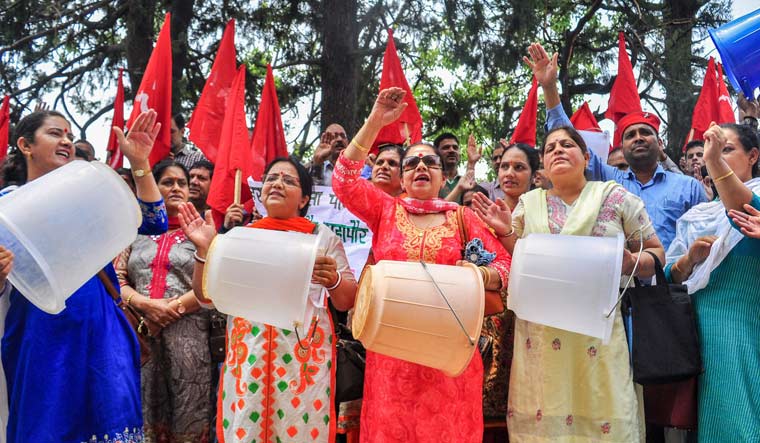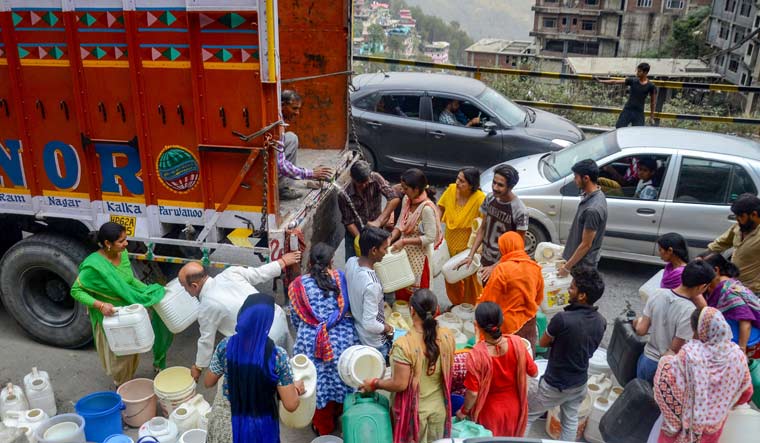Reeling under an acute water crisis, Shimla is like an old thirsty woman trying to look her best. The “smart city” tag has not helped much as funds have been liberally spent on giving a face lift to the erstwhile British summer capital and no serious effort has been made to strengthen the woefully inadequate basic amenities.
The peaceful hill station has been witnessing endless protests and road blockades over the past three weeks as water-starved residents have been forced to take to streets. Angry protesters staged dharnas, gheraoed offices and even marched to the chief minister’s residence at midnight. It is turning into a law and order situation and local Municipal Corporation (MC) is supplying water through tankers under police protection.
The residents of the city, which hosts lakhs of tourists every summer, are pleading to visitors to stay away. Bookings are being cancelled and some hoteliers are even offering refunds to maintain their goodwill. While hotels owners, taxi operators, travel agents and others connected with tourist trade are feeling the pinch, the vendors of bottled water and owners of private tankers are making a fast buck.
According to Mohit Sharma, a travel agent, arrivals have declined by more than 50 per cent and occupancy in hotels in the Fingask area, which are packed to the capacity around this time, has come down to 40 percent. The crisis has made headlines in international media, bringing a bad name to the destination. It does not augur well for the tourist industry, he laments.
Over two dozen tankers have been pressed into service by the Corporation and even a larger number of private tankers have been deployed by hotels. The situation is unprecedented and the authorities concerned seem helpless. Despite their best efforts, what the people in some worst-hit localities are getting is a few bucket of water after a gap of eight to ten days. “It is seventh day without water in my colony located just 500 metre away from the main water reservoir on the ridge,” says well-known author Raja Bhasin, who lives in Catholic Club.
Scarcity of water during peak tourist season has been a regular feature as discharge in various natural sources of water declines, but the city has never witnessed such a chaotic situation. Deficient precipitation, particularly the lack of snow during winter, has affected the availability more severely this season. However, the problem has been aggravated due to inefficient water infrastructure, mismanagement and inequitable distribution. The VIP residential areas have been getting water regularly in abundance and that has been the main reason for the public protests.
The high court has taken notice of the worsening situation and issued several directions to the government and the MC to ensure equitable distribution. It gave specific orders that there should be no preferential treatment to ministers, judges, bureaucrats and VIPs in supply of water through tankers and also directed that the supply to 224 hotels and guest houses which have not paid the water bills should be disconnected immediately. The court also ordered that the water connections from the main supply line to influential persons should be blocked forthwith. It also imposed a temporary ban on construction activity and washing of cars to help save precious water. Chief Justice Sanjay Karol even went around the city at night to have a first-hand assessment of the ground reality on Thursday.
The intervention of the court, which has been closely monitoring the situation, is itself an indication that the MC and other government departments concerned have not been discharging their duties. The issues flagged by the court have been responsible for inequitable distribution as a result of which the brunt of the shortage is being borne by the localities at the tail end of supply line and the areas with poor accessibility where supply through tankers is not feasible.
In fact, the distribution has started improving after the intervention of court, even though the availability declined further. Against a peak summer requirement of 44 MLD (million litres per day), the availability from all the sources has come down to about 22 MLD. “The MC has been supplying water on alternate days with availability of around 32 MLD for the past many years and even in the case of severe shortage, most localities were served on the fourth day and some on the fifth day. It is for the first time that people are not getting water even after eight to ten days,” says Sanjay Chauhan who maintains that residents are suffering more due to improper distribution.
Early this year, an acute water shortage in the South African city of Cape Town raised global concerns about the threat of water scarcity. Now the case of Shimla is being seen as a precursor to the impending water crisis that may befall the environmentally fragile Himalayan region. Not only the city, but most other parts of the state have been affected by water scarcity. Officially, out of the 9,590 drinking water supply schemes in the state, 350 have been critically affected while 1,131 were mildly affected. The neighbouring Uttrakhand, Nepal, Sikkim and other regions in the Himalayas have also been facing water shortage.
 CITU activists raise slogans with empty buckets during a protest against acute water shortage in Shimla | PTI
CITU activists raise slogans with empty buckets during a protest against acute water shortage in Shimla | PTI
The water woes of Shimlaites are the fallout of reckless urbanisation, wanton deforestation and populist policies of regularising illegal structures being followed by successive political regimes, irrespective of the party in power. Large tracts of lush green slopes have been transformed into veritable concrete jungles and the hills have been burdened way beyond the carrying capacity. There has been a sharp degradation of the environment, as a result of which snow season is shrinking and overall precipitation has been declining. As per studies conducted by the scientists of the Indian Meteorological Department, the snow season in Shimla has shrunk by 21 days over the 1991-2001 period. The seasonal snow cover is receding with each year and the region is frequently experiencing snowless winters. Many springs, streams and other sources of water have dried up and discharge is declining progressively. Consequently, the availability of fresh water is declining and the quantum of waste water is increasing progressively, causing further contamination of the water sources.
Unlike the British who gave top priority to protection of water sources, the government has miserably failed in preventing the degradation of even the catchment areas of the various khad and streams from where drinking water is supplied to the people. In fact, even reserve forest had been leased out to private parties in the name of eco-tourism.
The first water supply scheme was executed by the British in 1875 to tap spring sources from Dhalli Catchment forest located 12.85 km away to provide 4.54 MLD of water to cater to a population of 16,000. The area was kept out of bound to protect the source and today it is acclaimed as the best maintained forest of Asia. The scheme was augmented in 1889 and 1914 to tap additional 4.80 MLD of water and again in 1924 to lift 7.72 MLD from the Nauti Khad. Shimla was adjudged as one of the best water supply scheme in Asia in 1938.
The requirement started rising only after Shimla became the capital of Himachal, leading to frequent augmentation in 1981-82 (Gumma Khad), 1992 (Ashwani Khad) and 2009 (Giri Lift Scheme), which was supposed to suffice up to 2035. However, it did not fulfil the demand for even 10 years and now a new project to lift 55 MLD Sutlej water from the Kol Dam, located 50 km away, has been planned. The World Bank has agreed to fund the Rs 774 crore scheme which had been hanging fire for the past five years.
Apart from expeditiously implanting the Kol Dam project, the government needs to protect the green over the hills, which has come down heavily on illegal structures, and send stern message to the influential offenders by demolishing some of the high rise buildings as had been done in Kasauli on the orders of the Supreme Court. The government must shift out some of the major offices to decongest the state capital, close down hotels and guest houses in residential areas and impose a ban on opening of new hotels. Besides protecting the forests, a massive afforestation drive is needed to rehabilitate the degraded environment to help enhance the hydrological contribution from the mountain eco-systems.
In Sikkim, spring-shed development project is being implemented to help increase the flow in springs. China is planting 6.66 million hectares of new forests this year to help raise the area under forests from the current 21.7 per cent to 23 per cent by 2020, while France has decided raise a new suburban forest over an area of about 13 sq km to help combat the problem of air pollution in its national capital Paris. Himachal and other Himalayan states have no option but to follow suit as rivers emanating from the world’s tallest mountain cater to the largest chunk of population in the world.


